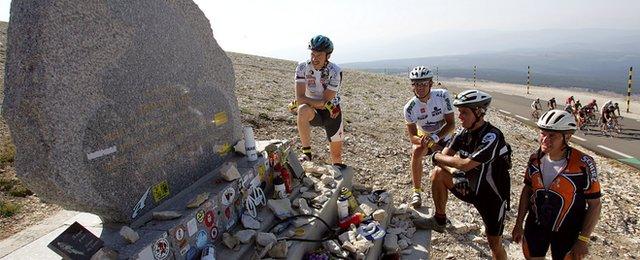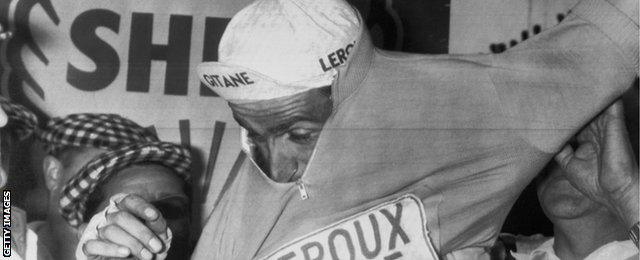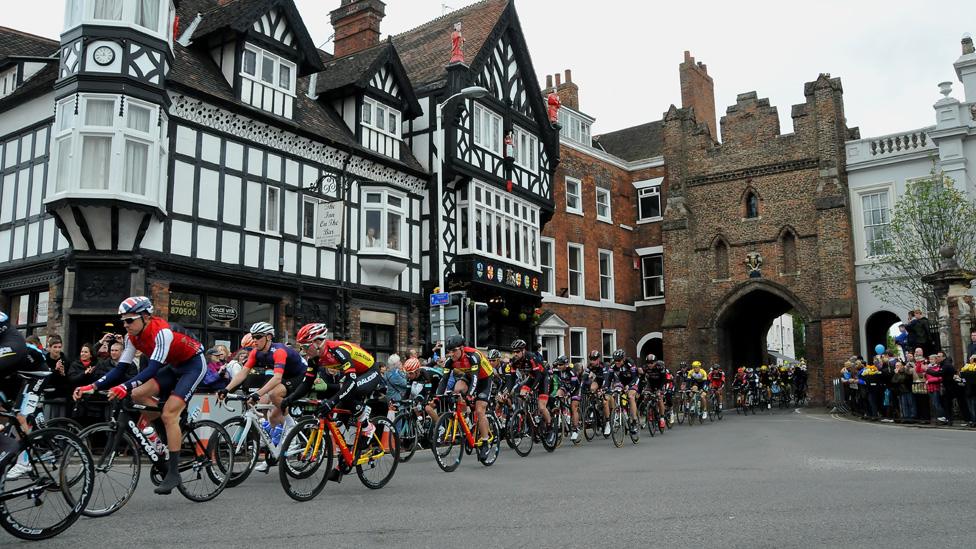Tommy Simpson: Tour de Yorkshire pays tribute to rider who died on Mont Ventoux
- Published

Tommy Simpson in the rainbow jersey of the Road World Championships winner
In the eyes of many, cycling was a minority sport until the summer of 2012, when Sir Chris Hoy and Laura Trott dazzled at the London Olympics and Sir Bradley Wiggins became the first Briton to win the Tour de France.
However, four decades previous the country had a rider who was arguably less celebrated, but nevertheless made history of his own.
Tommy Simpson was the first British cyclist to wear the famous yellow jersey and also sported the illustrious rainbow bands as winner of the Road World Championships.
Yet he will forever be remembered as the man who died on the gruelling ascent of Mont Ventoux.
Forty-nine years on, yellow bicycles will be mounted onto roofs, and bunting and lamp post banners will be hung in his honour as the Tour de Yorkshire rolls through Simpson's adopted hometown of Harworth, Nottinghamshire.
"It was a long time ago and cycling didn't have the profile it's got in Britain now, but he did," said Simpson's nephew Chris Sidwells, who works as a cycling journalist.
"Tom won some of the big races which Britain hasn't won since - some of his feats are still yet to be replicated."
'What he did was special'

There is a Tommy Simpson memorial on Mont Ventoux, and a similar stone paying tribute to him in Harworth
Simpson was just 29 when he collapsed through exhaustion climbing up the notorious mountain on the edge of the Alps, during the 13th stage of the Tour de France in 1967.
A post mortem examination showed traces of amphetamines in his blood, which was legal at the time but prompted the International Cycling Union to ban the use of any performance enhancing drugs in the sport.
Although Simpson's career was curtailed in its prime, he won several of the sport's best-known stage races, including Paris-Nice and the Tour of Flanders, as well as a prestigious UK award two years before dying.
"To be Sports Personality of the Year ahead of racing drivers like Jim Clark and footballers like Bobby Moore, you had to have done something," added Sidwells, who is covering stage two of the Tour de Yorkshire for BBC Radio Sheffield.
"What he did was special - completely out of the blue."
'A typical English gentleman'

Simpson puts on the Tour de France yellow jersey at the age of 23
Although born in County Durham, Simpson became Harworth's adopted son after growing up in the town and joining the local cycling club, which still runs with around 30 members.
June Evans is chairman of Harworth and Bircotes Town Council, which is organising the community celebrations this weekend, and remembers him well.
"I knew him vaguely simply because he used to leave his bicycle at my parents' house," she said.
"He was very polite, and always knocked on the door - 'is it alright if I can leave my bike?' Then off he would go, running to catch the bus.
"It was a major tragedy and I remember standing and watching his funeral in the town with the hundreds and hundreds of people who attended."
Simpson might have learned his trade in north Nottinghamshire, but to make a name for himself he had to move abroad.
"When he was in Paris the French people regarded him as a typical English gentlemen, and so he used to go around with his bowler hat, rolled up umbrella and a nice pinstripe suit," added Evans.
Tour de Yorkshire tribute

One of the yellow-painted bikes is already in position ahead of Saturday's stage
Wiggins and world champion Lizzie Armitstead will be among the riders to travel past the Tommy Simpson memorial stone on Saturday, with male and female cyclists riding the same route for the first time.
The museum, which exists in his memory, will be open to the public, displaying old jerseys, gloves and caps - but what would he have made of the tribute?
"He was a celebrity amongst his own circle and within his own sport," said Evans. "I think he'd have a big grin on his face, and that would be it."
Sidwells will be watching on as fans and locals alike pay their respects to his late uncle during a bike race which was fittingly created off the back of recent British success in the sport.
"It's fantastic - it's a tribute from the Tour de Yorkshire because it could've gone from Tickhill straight into Bawtry and off to the finish in Doncaster," he added.
"But they're going to do a right turn just to come through north Nottinghamshire, to go through Harworth."
- Published15 April 2016

- Attribution
- Published9 December 2015

- Attribution
- Published29 July 2015

- Published25 July 2019

- Published19 July 2016
